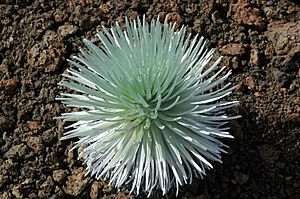Haleakala silversword facts for kids
Quick facts for kids Haleakala silversword |
|
|---|---|
 |
|
| Conservation status | |
| Scientific classification |
|
| Kingdom: | Plantae |
| Clade: | Tracheophytes |
| Clade: | Angiosperms |
| Clade: | Eudicots |
| Clade: | Asterids |
| Order: | Asterales |
| Family: | Asteraceae |
| Genus: | Argyroxiphium |
| Species: | |
| Subspecies: |
A. s. subsp. macrocephalum
|
| Trinomial name | |
| Argyroxiphium sandwicense subsp. macrocephalum (A. Gray) Mérat
|
|
The Haleakala silversword (scientific name: Argyroxiphium sandwicense subsp. macrocephalum) is a very special and rare plant. It's part of the daisy family called Asteraceae. In the Hawaiian language, this plant is known as ʻāhinahina, which means "very gray." This name perfectly describes its unique silvery leaves!
Contents
Where the Silversword Lives
The Haleakala silversword grows only on the island of Maui in Hawaii. You can find it high up on the dormant Haleakalā volcano. It lives at elevations above 2,100 meters (about 6,900 feet). This includes the volcano's summit, the edges of the crater, and the slopes around it, all within Haleakalā National Park.
For a while, the Haleakala silversword was a threatened species. This means it was in danger of disappearing forever. In the past, too many cattle and goats ate the plants. Also, people sometimes damaged them. This caused the plant to almost become extinct in the 1920s.
But thanks to strict rules and protection from the government, the silversword has made an amazing comeback! This is a great example of how conservation efforts can help save rare plants. Even though it's doing much better, we still need to protect it.
What the Silversword Looks Like
The Haleakala silversword has many leaves that look like swords. These leaves are thick and fleshy, like those of a succulent plant. They are covered with tiny, silvery hairs.
Silversword plants usually grow on volcanic cinder. This is a very dry, rocky ground. It can get freezing cold and very windy there. The plant's skin and hairs are super strong. They help the plant stand up to the strong winds and cold temperatures. They also protect it from drying out and from the strong sun.
The plant's base of leaves forms a round shape close to the ground. This part of the plant stays like this for most of its life. Some silverswords can live for more than 50 years! The leaves and their hairs are arranged in a special way. This helps them gather sunlight and focus it on the plant's growing tip. This can warm the tip by up to 20 degrees Celsius (68 degrees Fahrenheit). This is how the plant stays warm in the extreme high-altitude cold.
There is another type of silversword called the Mauna Kea silversword. It lives on Mauna Kea volcano. The main difference between them is the shape of their flower stalks. The Haleakala silversword has wider flower stalks. It also usually has more ray flowers (the petal-like parts) than the Mauna Kea silversword.
Life Cycle
When the plant gets old, usually when it's about 0.5 meters (1.6 feet) wide, something amazing happens. In just a few weeks, it grows a tall stalk with maroon-colored flowers. These flowers look a bit like sunflowers! Flowering usually happens from July to October. After the plant flowers and produces seeds, its leaves become soft and dry. Then, the plant dies. This type of plant that flowers once and then dies is called monocarpic.
The flowering stalk can grow up to 2 meters (6.6 feet) tall. It can have as many as 600 flower heads. Each head can have up to 40 outer ray flowers and 600 disk flowers. Flying insects, like a type of bee called Hylaeus volcanicus, help pollinate the flowers. The flower stalk also has many tiny, sticky hairs. These hairs stop crawling insects from climbing up and damaging the plant. Producing seeds is a very important time for the plant. If insects damage the flowers or stalk before the seeds are ready, the plant might not be able to make any new plants.
History and Conservation Efforts
Before Haleakalā National Park was created, visitors to the volcano's summit often harmed the silversword plants. People would pull them up and roll them down the rocky slopes. They also dried the flowers for decorations or used the plants to start fires. The silversword has delicate, shallow roots. This means it's very sensitive to people walking too close to it. Goats also caused a lot of damage by eating the plants and stopping them from reproducing.
Now, animals like goats are kept out of the crater area with fences. Also, it is against the law for humans to damage these plants. These efforts have helped the Haleakala silversword recover and thrive once again.
Gallery










